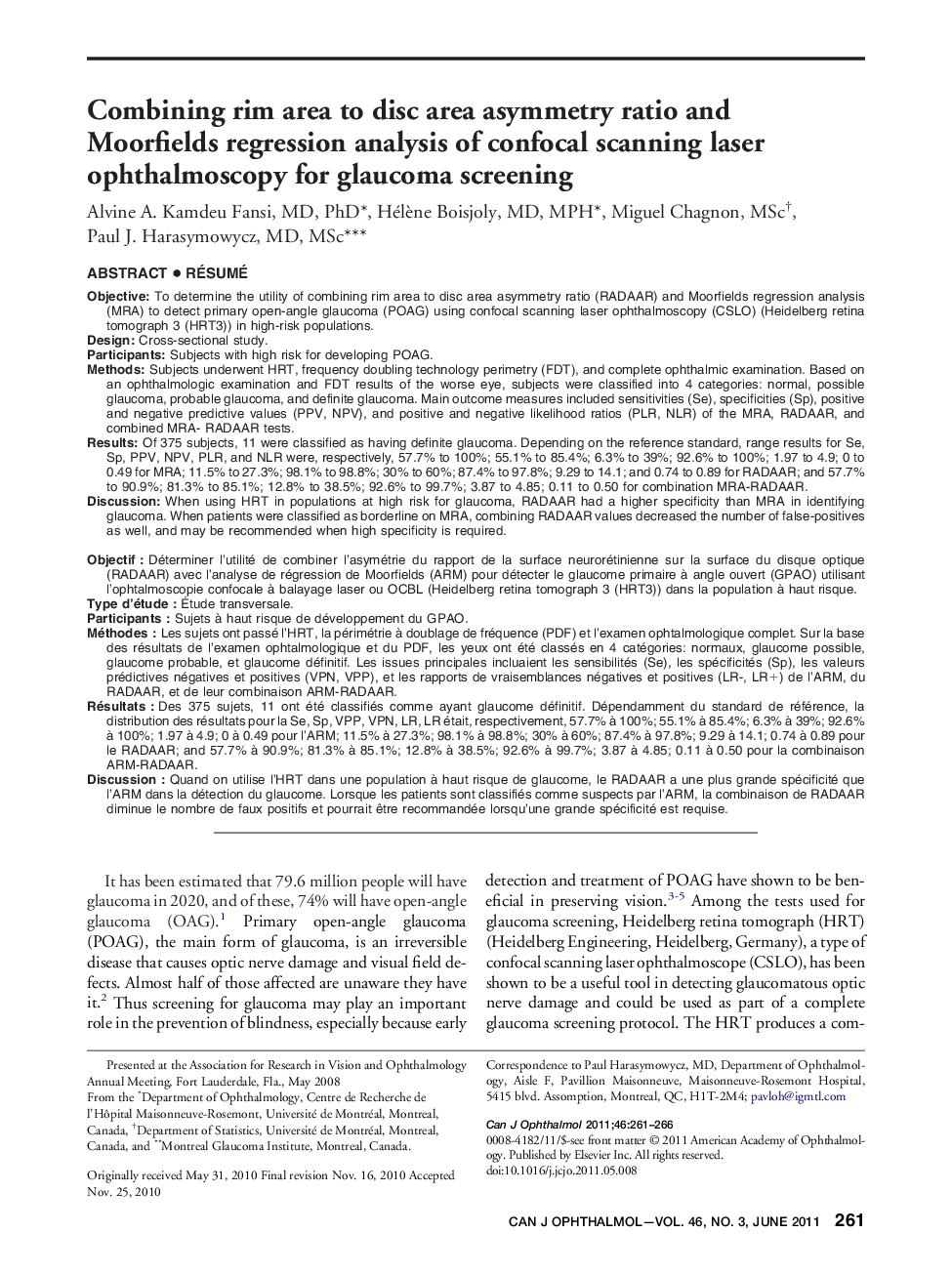| کد مقاله | کد نشریه | سال انتشار | مقاله انگلیسی | نسخه تمام متن |
|---|---|---|---|---|
| 4009821 | 1602423 | 2011 | 6 صفحه PDF | دانلود رایگان |

ObjectiveTo determine the utility of combining rim area to disc area asymmetry ratio (RADAAR) and Moorfields regression analysis (MRA) to detect primary open-angle glaucoma (POAG) using confocal scanning laser ophthalmoscopy (CSLO) (Heidelberg retina tomograph 3 (HRT3)) in high-risk populations.DesignCross-sectional study.ParticipantsSubjects with high risk for developing POAG.MethodsSubjects underwent HRT, frequency doubling technology perimetry (FDT), and complete ophthalmic examination. Based on an ophthalmologic examination and FDT results of the worse eye, subjects were classified into 4 categories: normal, possible glaucoma, probable glaucoma, and definite glaucoma. Main outcome measures included sensitivities (Se), specificities (Sp), positive and negative predictive values (PPV, NPV), and positive and negative likelihood ratios (PLR, NLR) of the MRA, RADAAR, and combined MRA- RADAAR tests.ResultsOf 375 subjects, 11 were classified as having definite glaucoma. Depending on the reference standard, range results for Se, Sp, PPV, NPV, PLR, and NLR were, respectively, 57.7% to 100%; 55.1% to 85.4%; 6.3% to 39%; 92.6% to 100%; 1.97 to 4.9; 0 to 0.49 for MRA; 11.5% to 27.3%; 98.1% to 98.8%; 30% to 60%; 87.4% to 97.8%; 9.29 to 14.1; and 0.74 to 0.89 for RADAAR; and 57.7% to 90.9%; 81.3% to 85.1%; 12.8% to 38.5%; 92.6% to 99.7%; 3.87 to 4.85; 0.11 to 0.50 for combination MRA-RADAAR.DiscussionWhen using HRT in populations at high risk for glaucoma, RADAAR had a higher specificity than MRA in identifying glaucoma. When patients were classified as borderline on MRA, combining RADAAR values decreased the number of false-positives as well, and may be recommended when high specificity is required.
RésuméObjectifDéterminer l'utilité de combiner l'asymétrie du rapport de la surface neurorétinienne sur la surface du disque optique (RADAAR) avec l'analyse de régression de Moorfields (ARM) pour détecter le glaucome primaire à angle ouvert (GPAO) utilisant l'ophtalmoscopie confocale à balayage laser ou OCBL (Heidelberg retina tomograph 3 (HRT3)) dans la population à haut risque.Type d'étudeÉtude transversale.ParticipantsSujets à haut risque de développement du GPAO.MéthodesLes sujets ont passé l'HRT, la périmétrie à doublage de fréquence (PDF) et l'examen ophtalmologique complet. Sur la base des résultats de l'examen ophtalmologique et du PDF, les yeux ont été classés en 4 catégories: normaux, glaucome possible, glaucome probable, et glaucome définitif. Les issues principales incluaient les sensibilités (Se), les spécificités (Sp), les valeurs prédictives négatives et positives (VPN, VPP), et les rapports de vraisemblances négatives et positives (LR-, LR+) de l'ARM, du RADAAR, et de leur combinaison ARM-RADAAR.RésultatsDes 375 sujets, 11 ont été classifiés comme ayant glaucome définitif. Dépendamment du standard de référence, la distribution des résultats pour la Se, Sp, VPP, VPN, LR, LR était, respectivement, 57.7% à 100%; 55.1% à 85.4%; 6.3% à 39%; 92.6% à 100%; 1.97 à 4.9; 0 à 0.49 pour l'ARM; 11.5% à 27.3%; 98.1% à 98.8%; 30% à 60%; 87.4% à 97.8%; 9.29 à 14.1; 0.74 à 0.89 pour le RADAAR; and 57.7% à 90.9%; 81.3% à 85.1%; 12.8% à 38.5%; 92.6% à 99.7%; 3.87 à 4.85; 0.11 à 0.50 pour la combinaison ARM-RADAAR.DiscussionQuand on utilise l'HRT dans une population à haut risque de glaucome, le RADAAR a une plus grande spécificité que l'ARM dans la détection du glaucome. Lorsque les patients sont classifiés comme suspects par l'ARM, la combinaison de RADAAR diminue le nombre de faux positifs et pourrait être recommandée lorsqu'une grande spécificité est requise.
Journal: Canadian Journal of Ophthalmology / Journal Canadien d'Ophtalmologie - Volume 46, Issue 3, June 2011, Pages 261–266